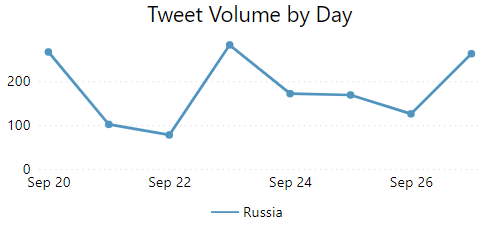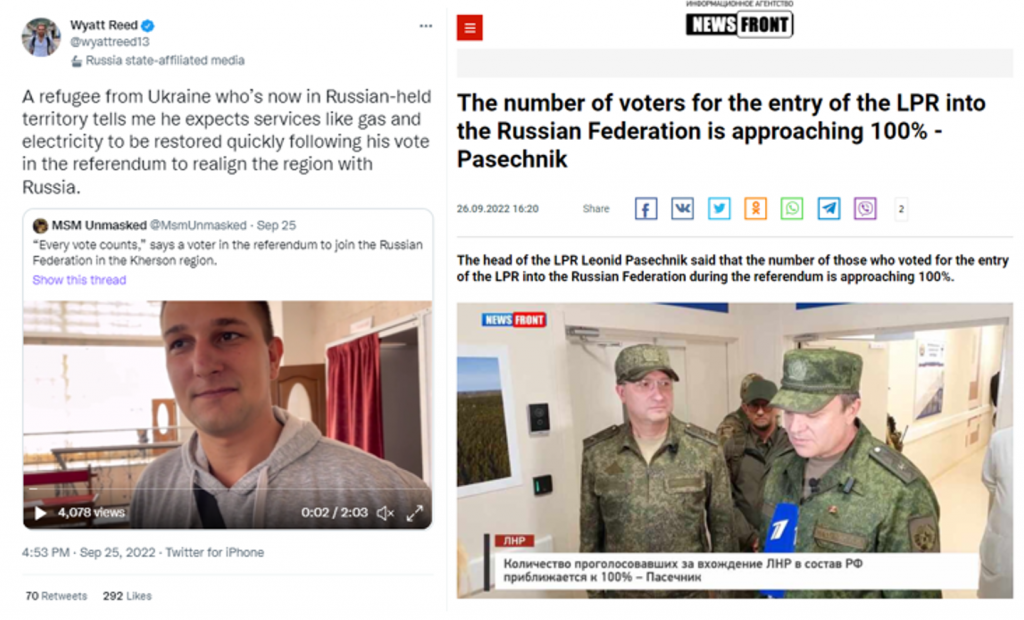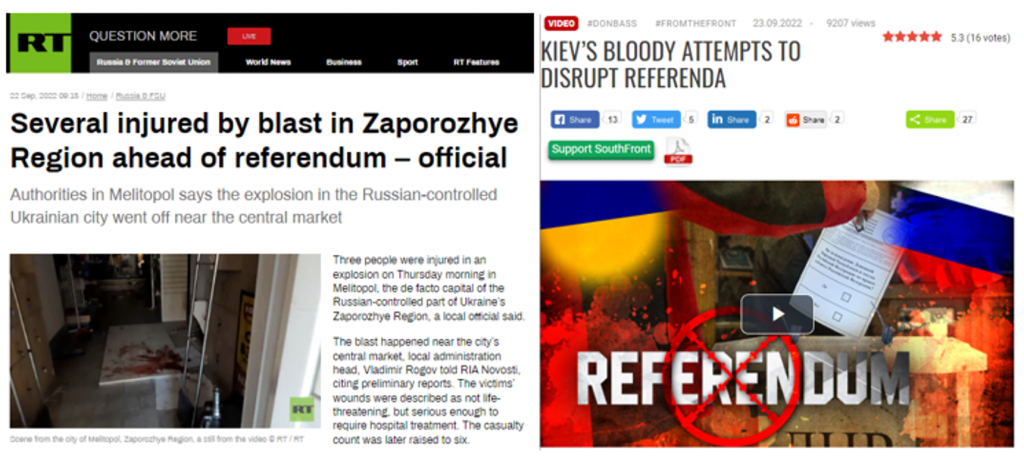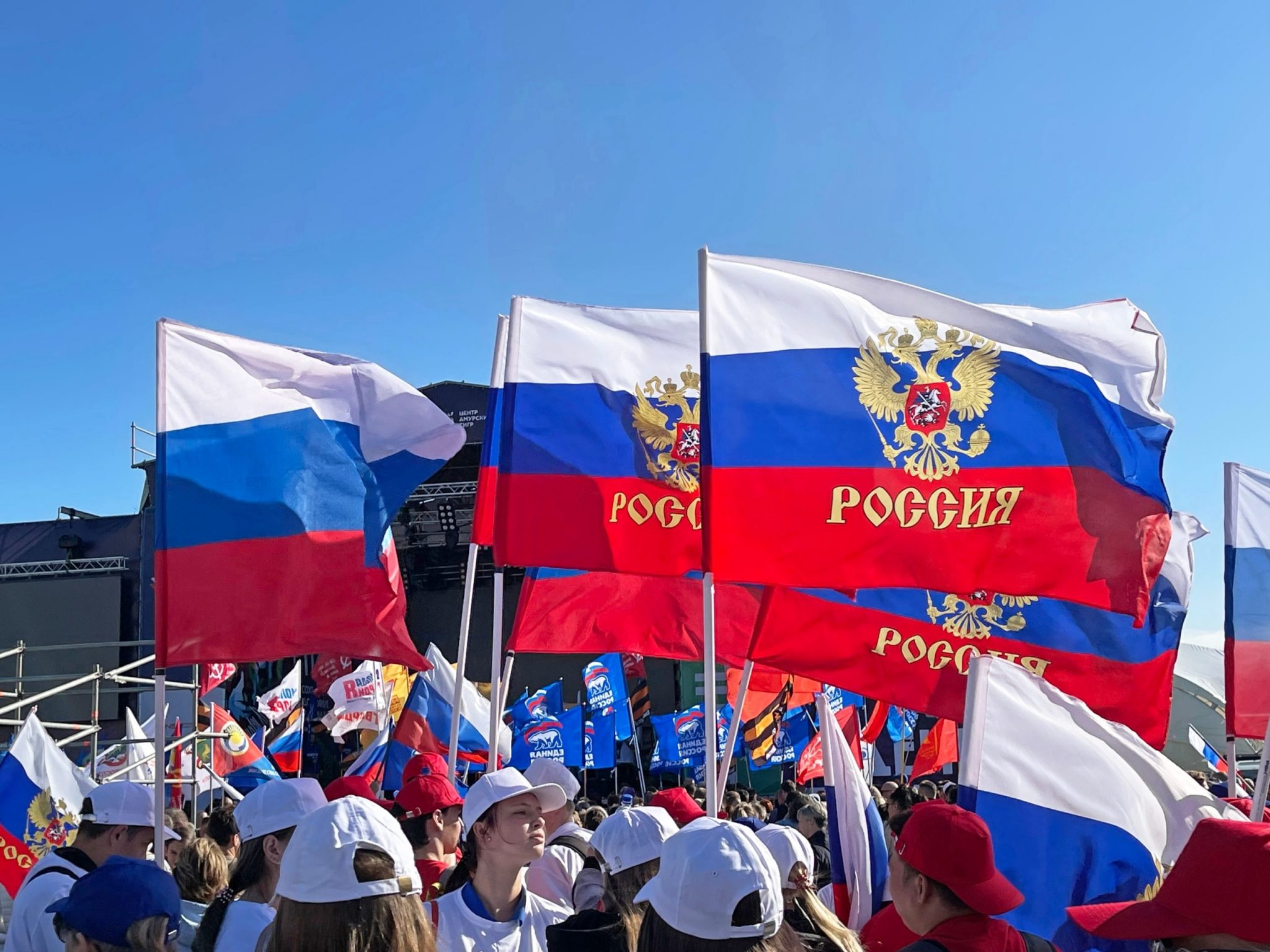Overview
On Tuesday, Kremlin-staged referendums in occupied areas of Ukraine laid the groundwork for Russia to announce the annexation of roughly 15 percent of Ukraine’s territory. A large-scale propaganda push accompanied these widely discredited elections. In the week before polls closed, Russian state media and diplomats mentioned terms related to the referendums in more than 2,000 tweets, making it one of the highest volume propaganda campaigns of the war. This messaging sought to legitimize the referendums by showcasing voters who were eager to join Russia and international observers who approved of the voting practices. The propaganda effort also demonized Ukraine, claiming that Kyiv launched a terrorist campaign that tried but failed to prevent people from casting their vote.
By the Numbers
Monitored Russian accounts mentioned terms related to the referendums in more than 2,000 tweets in the week before the final ballot was cast. The term “referendum” alone was used in around 1,400 tweets, which generated nearly 16,000 retweets and 53,000 likes. This propaganda campaign was one of the most aggressive of the war. It outpaced other notable messaging drives, including the effort to cover up Russian war crimes in Bucha. Across seven days, RIA Novosti posted “referendum” most frequently, but the popular RT en Español account received the most retweets on referendum content. After Russia and Ukraine, posts about the referendum most frequently mentioned Mexico, the United States, Germany, and the European Union. Most of the propaganda was delivered in Russian. English, Arabic, and Spanish-speakers were the next most targeted audiences.

Volume of tweets by Russian state media and diplomatic accounts mentioning “referendum” between September 20 and 27.
What We’re Seeing on Hamilton 2.0
Russian accounts argued that the referendums were popular and lawful, and they claimed that Ukraine had carried out a terrorist campaign to disrupt the vote.
Before the outcomes were announced, Kremlin-affiliated media sought to legitimize the referendums by showing quotes and polls that indicated a nearly universal desire to join Russia within occupied regions. State media highlighted voters saying that “people really want to be part of Russia” and arguing that a vote for annexation was a “vote for human life” because “no one will protect us except Russia.” Monitored Russian accounts sent posts about students voting for the first time and elderly people turning out “despite the rain and harsh weather conditions.” Other tweets showed people confident that Russia would quickly restore access to electricity and gas. There was also coverage of pro-annexation rallies inside Russia, with RIA Novosti reporting that 50,000 people came to Moscow to demonstrate support. As voting was underway, the Russian intelligence-linked site NewsFront stated that the proportion of pro-Russian voters in Luhansk was “approaching 100 percent.” Sputnik put forward a more modest estimate, saying only 95 percent of people in Luhansk and Donetsk would vote to join Russia. Tass claimed that 93 percent of those in Zaporizhzhia cast a ballot in favor of Russian annexation. Ultimately, the Kremlin said that all four regions voted to join Russia, with vote shares ranging from 87 to 99 percent.

Moscow-funded outlets insisted the referendums were in line with international norms. RIA Novosti stated that more than 1,000 people would serves as election observers, and Tass noted that there would be 100 international observers from more than 40 countries. State media played up positive quotes from Western election observers, including those from the Czech Republic, Germany, Italy, and the Netherlands. Outlets claimed turnout was high and results were valid.
Russian accounts also pushed back on Western statements about votes being manipulated. Foreign Minister Sergey Lavrov claimed the West had double standards and was throwing “a tantrum” about the referendums. RIA Novosti argued that “Western media are inflating fakes” about the referendum. Other accounts made fun of claims that residents in occupied regions were voting at gun point by showing Russian soldiers chatting with children who were in line with their parents to vote.
The real threat, according to Russian propagandists, came from the Ukrainian military. State media said that Kyiv “attempted to terrorize” people ahead of the vote. Ukrainian forces were shown “launching a massive bombardment against residential areas.” RT lifted up quotes from a local official who called one of Ukraine’s supposed assaults a “terrorist act.” Other outlets showed Kyiv allegedly killing children, bombing cars, targeting grocery stores, and spreading disinformation about mines to scare people from going to vote. The Russian-intelligence run site SouthFront claimed that Ukraine was “targeting civilians and sending death squads to assassinate anyone” connected to the referendums.

Meanwhile, officials from Russia and the self-proclaimed republics were depicted as doing all they could to protect voters. RT’s Russian-language outlet also claimed that the Donetsk People’s Republic exposed a terrorist plot by Ukrainian intelligence, and RIA Novosti noted that more than 2,500 police officers were deployed to protect those casting a ballot.
Kremlin-backed accounts also threatened the West. RT Editor-in-Chief Margarita Simonyan warned that after occupied regions join Russia, any strikes on their territory would “become a full-fledged war of Ukraine and NATO with Russia, unleashing Russia’s hands in all respects.” Both President Vladimir Putin and former President Dmitry Medvedev said that Russia would use all available means to secure its territory, which many saw as thinly veiled references to Moscow’s nuclear capabilities. Tass also shared Medvedev’s claim that the referendums were correcting an injustice and making the “geopolitical transformation of the world irreversible.”
Why It Matters
These Moscow-directed referendums mark an escalation on the ground and in the information space. Putin will almost certainly use the elections’ outcome to claim Ukrainian territory, and he has hinted that nuclear weapons could be used to defend that land. Throughout the referendums, Russian propagandists increased their efforts to co-opt democratic ideas and discredit Ukraine’s right to its territory. While the elections were illegal under international law, Kremlin-directed outlets said they were in line with people’s right to self-determination, the UN charter, and the standards of foreign election monitors. And while Russia launched a war of choice, propagandists claimed that Ukraine was the aggressor and willing to stage terrorist campaigns to undermine democratic rights. Kremlin-linked accounts will likely double down on both narratives going forward.
The views expressed in GMF publications and commentary are the views of the author alone.





